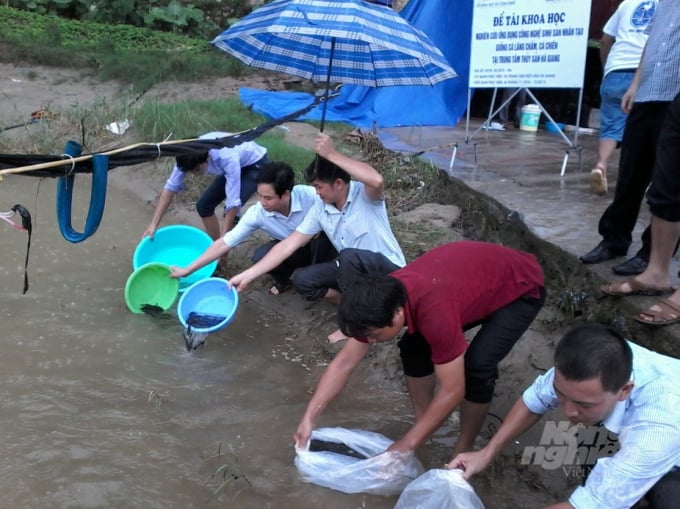May 29, 2025 | 09:28 GMT +7
May 29, 2025 | 09:28 GMT +7
Hotline: 0913.378.918
May 29, 2025 | 09:28 GMT +7
Hotline: 0913.378.918

Ha Giang province organizes the release of rare and precious fish species on the rivers running through the area. Photo: Dao Thanh.
Ha Giang province has a relatively high density of rivers and streams. Most of the rivers there have uneven depth, steep slopes, and many rapids. This is the ideal living environment for precious fishes to live such as catfish and Denti carp and goby.
However, the fact that local people are trying to catch them under an 'exterminated form' has made the number of these precious fish species increasingly scarce. To maintain and replicate their population, every year, Ha Giang organizes to release them for reproduction in Lo, Gam, Chay, and Nho Que rivers.
To regenerate river aquatic resources, from 2016 to 2021, Ha Giang province annually produced more than 5,000 special fish of all kinds. The breeds selected for release have high quality and survivability.
In 2016 for example, the province released 7,000 fingerlings of catfish and 3,000 Giant Devil Catfish breeds. In 2017, 2,000 catfish fingerlings and 1,000 breeds of Giant Devil Catfish were released into the Gam River in Bac Me district. In 2018, about 1,000 Dam Xanh fish and 1,000 Anh Vu carp were released into the rivers.
Mr. Nguyen Anh Tu, Deputy Director of the Fisheries Center of Ha Giang province, said the selection of fish for release to the natural environment was carried out carefully to ensure its size and good health capable of maturing and quickly adapting to the aquatic conditions.
The regenerative release program is hoped to recover the fish herd, thereby helping to balance the ecosystem; restore and develop a number of fish species that are in danger of extinction due to overexploitation and unfavorable habitat conditions.

Ha Giang province has annually released an average of about 5,000 rare fish into the rivers since 2016. Photo: Dao Thanh.
Recently, at the beginning of April 2022, Hoang Su Phi district People's Committee released nearly 5 quintals of traditional fingerlings into the basin of the Chay River hydropower reservoir. The fingerlings release is part of a significant practical policy of the Hoang Su Phi district in protecting and developing aquatic resources that are showing signs of decline in the area and improving the ecological environment.
According to leaders of Hoang Su Phi, through the activity of releasing fish to regenerate aquatic resources, the district aims to raise awareness and responsibility of all classes of locals in the protection, conservation, and development of aquatic fishery resources for the present and future generations, preventing all acts of using destructive means in fishing and protecting the ecological environment and biodiversity, contributing to the sustainable development of fisheries in the area.
After releasing the fingerlings, the Hoang Su Phi district authority also set up a patrol team for the additional fish releasing area reminding people not to fish for 5-7 days. The team has tasks to prevent all destructive fishing forms, ensure that the released fingerlings are healthy and have the highest survival rate, and strongly grow to be able to contribute to environmental and biodiversity protection and conservation of aquatic resources in the Chay River.
Along with the regeneration of precious and indigenous fish breeds in the natural environment, the Agriculture and Rural Development sector of Ha Giang province and localities also focus on solutions to propagate people thereby creating a strong change from thoughts to actions in protecting aquatic resources; strengthening the management of fishing in the area, promptly detect and strictly handle cases of using electric pulses, explosives and chemicals in fishing.
Ha Giang authorities also encourage people to actively participate in releasing aquatic breeds into the natural environment in order to balance the ecosystem and regenerate aquatic resources, contributing to effective and sustainable fishery development.
Translated by Linh Nguyen
/2025/05/25/4127-3-073637_820.jpg)
(VAN) Thanks to the promotion from an FAO-implemented project, vegetable production in greenhouses in Moc Chau has seen strong development, from 1.5 hectares in 2021 to nearly 50 hectares in 2024.

(VAN) FAO has recently supported USD 140,000 to implement the project 'Risk mitigation human-animal interface risks through disease control initiatives in pig farming.'

(VAN) The People's Committee of Tra Vinh province has approved an adjustment to the investment policy for the Green Hydrogen Plant project, increasing its area to approximately 52.76 hectares.
![Reducing emissions from rice fields: [2] Farmers’ commitment to the soil](https://t.ex-cdn.com/nongnghiepmoitruong.vn/608w/files/news/2025/05/05/dsc08881jpg-nongnghiep-140632.jpg)
(VAN) Clean rice cultivation model in Thuong Tan commune, Bac Tan Uyen district, is assisting local residents in achieving sustainable agriculture by substantially reducing costs, increasing productivity, and protecting the environment.

(VAN) At the conference to disseminate Resolution No. 68, AgriS introduced its digital agricultural ecosystem and reaffirmed its commitment to accompanying the Government in promoting private sector development and sustainable agriculture.

(VAN) 'Blue Ocean - Blue Foods' initiative is designed to restore marine ecosystems and establish sustainable livelihoods for local communities by cultivating a minimum of 1,000 hectares of cottonii seaweed in the first three years.
/2025/05/21/4642-3-112707_603.jpg)
(VAN) The V-SCOPE project has made direct contributions to three out of six pillars of the Comprehensive Strategic Partnership between Vietnam and Australia.